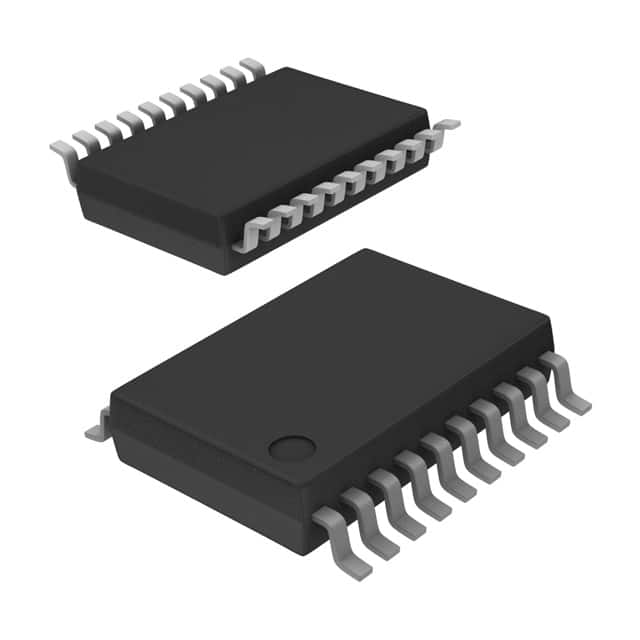Lihat spesifikasi untuk detail produk.

SN74ABT2245DBRG4
Product Overview
- Category: Integrated Circuit (IC)
- Use: Bus Transceiver
- Characteristics: High-speed, bidirectional voltage-level translator
- Package: 20-pin TSSOP (Thin Shrink Small Outline Package)
- Essence: Transfers data between two bidirectional bus systems with different voltage levels
- Packaging/Quantity: Tape and Reel, 2500 units per reel
Specifications
- Supply Voltage Range: 4.5V to 5.5V
- Input Voltage Range: 0V to VCC
- Output Voltage Range: 0V to VCC
- Operating Temperature Range: -40°C to +85°C
- Propagation Delay Time: 3.8ns (typical)
- Output Drive Capability: ±12mA
Detailed Pin Configuration
The SN74ABT2245DBRG4 has a total of 20 pins. The pin configuration is as follows:
- OE (Output Enable) 1
- A1 (Data Bus A) 1
- B1 (Data Bus B) 1
- A2 (Data Bus A) 2
- B2 (Data Bus B) 2
- A3 (Data Bus A) 3
- B3 (Data Bus B) 3
- GND (Ground)
- B4 (Data Bus B) 4
- A4 (Data Bus A) 4
- B5 (Data Bus B) 5
- A5 (Data Bus A) 5
- B6 (Data Bus B) 6
- A6 (Data Bus A) 6
- VCC (Supply Voltage)
- DIR (Direction Control)
- B7 (Data Bus B) 7
- A7 (Data Bus A) 7
- B8 (Data Bus B) 8
- A8 (Data Bus A) 8
Functional Features
- Bidirectional voltage-level translation between two bus systems
- Automatic direction control based on DIR pin
- High-speed operation with minimal propagation delay
- Output drive capability for driving capacitive loads
Advantages and Disadvantages
Advantages: - Enables communication between bus systems with different voltage levels - Fast data transfer with low propagation delay - Compact package size for space-constrained applications
Disadvantages: - Limited to a specific number of data bus lines (8 in this case) - Requires careful consideration of voltage compatibility between bus systems
Working Principles
The SN74ABT2245DBRG4 is a bidirectional voltage-level translator that allows data transfer between two bus systems operating at different voltage levels. The direction of data flow is controlled by the DIR pin. When DIR is high, data flows from Bus A to Bus B, and when DIR is low, data flows from Bus B to Bus A.
The IC uses a combination of level-shifting circuitry and tri-state buffers to achieve bidirectional data transfer. It ensures that the voltage levels of the input and output signals are compatible with the respective bus systems.
Detailed Application Field Plans
The SN74ABT2245DBRG4 finds applications in various fields where there is a need to interface between bus systems operating at different voltage levels. Some common application areas include:
- Microcontroller interfacing: It enables communication between microcontrollers operating at different voltage levels, allowing them to exchange data seamlessly.
- Industrial automation: The IC facilitates communication between different modules or devices within an industrial automation system, which may operate at different voltage levels.
- Communication systems: It can be used in communication systems to interface between different buses, such as UART, SPI, or I2C, that operate at different voltage levels.
- Automotive electronics: The IC can be employed in automotive applications where different subsystems or modules require voltage-level translation for data exchange.
Detailed and Complete Alternative Models
- SN74LVC4245A: This is a similar bidirectional voltage-level translator with 8-bit data bus capability. It operates at a lower supply voltage range of 1.65V to 3.6V.
- SN74AVC4T245: This is a compact bidirectional voltage-level translator with 4-bit data bus capability. It is designed for space-constrained applications and operates at a supply voltage range of 1.2V to 3.6V.
- SN74HCT245: This is an octal bus transceiver with 8-bit data bus capability. It operates at a wider supply voltage range of 4.5V to 5.5V and is compatible with TTL logic levels.
These alternative models provide options with varying features and specifications to suit different application requirements.
(Note
Sebutkan 10 pertanyaan dan jawaban umum terkait penerapan SN74ABT2245DBRG4 dalam solusi teknis
Sure! Here are 10 common questions and answers related to the application of SN74ABT2245DBRG4 in technical solutions:
Q: What is SN74ABT2245DBRG4? A: SN74ABT2245DBRG4 is a bidirectional octal bus transceiver with 3-state outputs, designed for asynchronous communication between buses operating at different voltage levels.
Q: What is the voltage range supported by SN74ABT2245DBRG4? A: SN74ABT2245DBRG4 supports a voltage range from 4.5V to 5.5V.
Q: How many channels does SN74ABT2245DBRG4 have? A: SN74ABT2245DBRG4 has 8 bidirectional channels.
Q: Can SN74ABT2245DBRG4 be used for level shifting between different voltage domains? A: Yes, SN74ABT2245DBRG4 can be used for level shifting between voltage domains as it supports bidirectional communication.
Q: What is the maximum data rate supported by SN74ABT2245DBRG4? A: SN74ABT2245DBRG4 supports a maximum data rate of 100 MHz.
Q: Does SN74ABT2245DBRG4 have built-in ESD protection? A: Yes, SN74ABT2245DBRG4 has built-in ESD protection, making it more robust against electrostatic discharge.
Q: Can SN74ABT2245DBRG4 be used in both parallel and serial communication systems? A: Yes, SN74ABT2245DBRG4 can be used in both parallel and serial communication systems, depending on the application requirements.
Q: What is the power supply voltage required for SN74ABT2245DBRG4? A: SN74ABT2245DBRG4 requires a power supply voltage of 4.5V to 5.5V.
Q: Does SN74ABT2245DBRG4 support hot-swapping capability? A: No, SN74ABT2245DBRG4 does not support hot-swapping capability. It is recommended to power off the device before connecting or disconnecting it from the bus.
Q: Can SN74ABT2245DBRG4 be used in automotive applications? A: Yes, SN74ABT2245DBRG4 is suitable for automotive applications as it meets the necessary standards and has a wide operating temperature range.
Please note that these answers are general and may vary depending on the specific application and requirements.

